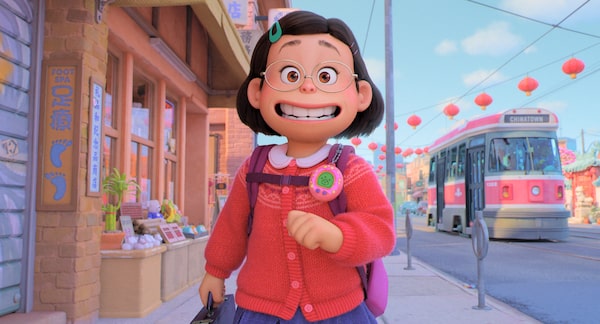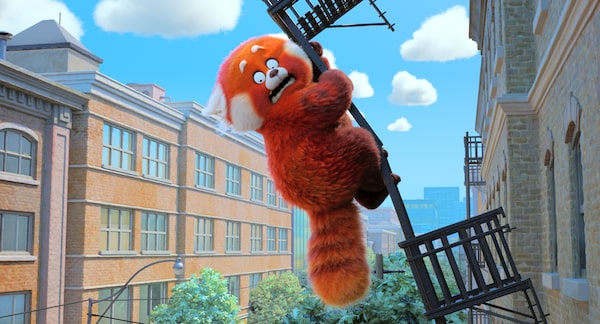
In Disney and Pixar’s Turning Red, 13-year-old Meilin Lee is happy with her friends, school and, her family, until the day she begins to poof into a giant red panda.Pixar/Disney / Pixar
Plan your screen time with the weekly What to Watch newsletter. Sign up today.
Turning Red
Directed by Domee Shi
Written by Domee Shi and Julia Cho
Featuring the voices of Rosalie Chiang, Sandra Oh and Maitreyi Ramakrishnan
Classification PG; 100 minutes
Streaming on Disney+ starting March 11
Critic’s Pick
Word on the street is that Pixar is dead. Haven’t you heard? Parent company Disney certainly seems to think so, having punted the past few Pixar titles (Soul, Luca and now Turning Red) directly to streaming, while giving its other animated films (we need to talk about Bruno) the full-fledged theatrical treatment. True, there has been a noticeable dip, perhaps outright plunge, in quality on Pixar’s notoriously finicky factory floor. Does anyone even still remember that 2020′s Onward exists? Or what it was about? (Orcs, is the answer.)
But on the streets of Toronto – specifically the bubblegum-backgrounded pavement found in Turning Red – Pixar’s moribund rep is entirely undeserved. Canadian director Domee Shi’s new film, which is proudly set in the city circa 2002, not only reminds you of Pixar’s strength in general, but how animated films can deliver layered, tricky, emotionally resonant stories with a powerful, punchy pop.
And this is not just the Torontonian in me talking. Sure, there is a reasonable argument to be made that hometown audiences are predisposed to loving whatever Turning Red might have turned out to be: any opportunity to show international audiences that we, too, live in a world-class city deserving of Pixar’s many expensive pixels. Shi certainly leans into this vibe, too, at least early on: t=The first five minutes of her film jam in so many only-in-Toronto references with such specificity (the exact texture of a TTC streetcar seat, the weathered look of a Daisy Mart store sign, the useless design of a city trash bin) that it edges close to a weirdly expensive tourism campaign.
But after some Cancon scene-setting – and creative, alternate-reality touches that ensure that the Toronto of Turning Red isn’t quite the Toronto of our world (it’s unclear whether the film’s Chinatown is the one found on Spadina or Gerrard, for instance) – Shi’s film becomes more than a metropolitan love letter. This is an energetic, heartfelt, poignant and often delightfully subversive story of one young girl’s path into adulthood, and embrace of her cultural heritage. The fact that it’s set in Toronto is simply the glaze on the Timbit.
The odd Pixar film focused on humans instead of talking toys, cars, fish or robots, Turning Red follows the adventures of 13-year-old Mei Lee (Rosalie Chiang), a bright student and devoted daughter who is trying to balance her social and familial circles.
Her tight group of friends (a proudly multicultural clique that includes the deadpan Priya, voiced by Mississauga’s Maitreyi Ramakrishnan) want to hang out and moon over the boy band 4*Town, like typical tween-age girls. But Mei’s strict helicopter mom Ming (Sandra Oh) wants her close at all times, partly to help run the family’s temple gift shop, but also because … the Lee clan has an ancestral connection to a magical panda curse/superpower. Specifically: On the cusp of adulthood, all Lee women turn into giant red pandas whenever they experience strong emotions. And now it is Mei’s turn to learn to control her inner beast.
Continuing the themes of her Oscar-winning animated short Bao – namely, the tension between raising a child and learning to let go – Shi’s film uses a smart, clever conceit to talk about everything from puberty (particularly menstruation) to the immigrant experience to bodily autonomy. Sure, Teen Wolf sorta got there first, but this is smart, elevated children’s fare. Not many animated films could get away with a line like, “My panda, my choice,” but good on Shi and Pixar for pushing the envelope. What’s more: Mei is one of Pixar’s most fully realized human characters – a truly singular creation that feels real, lived-in and utterly relatable (even if you didn’t grow up with her particular Toronto/supernatural circumstances).

Turning Red features the voice talents of Rosalie Chiang as the voice of Mei Lee.Pixar/Disney / Pixar
Turning Red delivers on almost every other level, too. The voice performances are warm and wonderful (Oh is particularly strong as a mother who both cannot and desperately needs to give her child space), the humour sharp (younger viewers will likely be in hysterics over Mei’s poofy, furry transformations) and the action epic (there is a scene set inside the SkyDome – not yet the Rogers Centre, thank god – that is genuinely thrilling). Even the fictitious 4*Town songs hit just the right mark of pop cheese and swoon-worthy sincerity (as well they should, given they’re written by chart-topping siblings Billie Eilish and Finneas O’Connell).
There may not be a gut-punch moment of overwhelming emotion like, say, the climax of Toy Story 3, the profoundly unexpected imagination of Up, or the form-busting audaciousness of Wall-E (though the plush-toy-ready Panda Mei is as easy a product to sell as Toy Story 4′s Forky). But Turning Red immediately announces itself as top-tier Pixar.
Ultimately, the only disappointment of Shi’s film is one entirely out of her control: the fact that Toronto audiences (and audiences anywhere in North America) cannot see Turning Red on the big-screen canvas that it surely deserves. Now that’s a world-class disservice, for a world-class film.
Sign up for The Globe’s arts and lifestyle newsletters for more news, columns and advice in your inbox.
 Barry Hertz
Barry Hertz